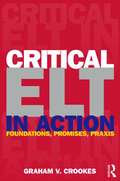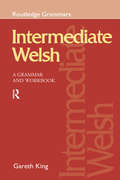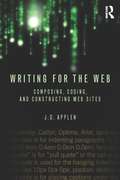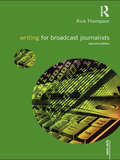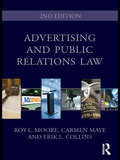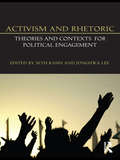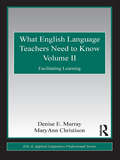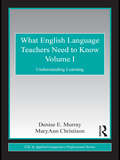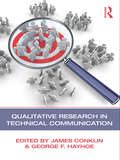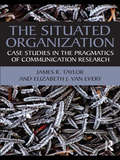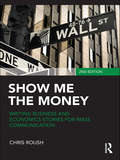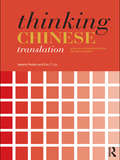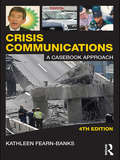- Table View
- List View
Critical ELT in Action: Foundations, Promises, Praxis
by Graham V. CrookesUniquely bridging theory and practice, this text introduces and overviews the various domains associated with the term critical pedagogy in the field of TESOL/ELT. Critical pedagogy addresses concepts, values, curriculum, instructional and associated practices involved in language teaching for social justice. Bringing critical pedagogy to classroom practitioners in a practical and comprehensible way, the text is designed to help teachers get started on critically grounded work in their own teaching. Features• Textbook extracts offer direct and quick illustration of what this perspective might look like in practice• Coverage of feminist and anti-racist pedagogies; sexual identity, oppression and pedagogy; peace and environmental education; and critical English as a foreign language—and their implications for second-language teaching • Historical background• Theoretical background on language and learning• Consideration of applicability of critical/radical educational concepts and traditions to non-Western cultural contexts • A focus on issues of compromise and resistance This original, timely, and informative text is ideal for any course on methods and approaches in TESOL.
Critical ELT in Action: Foundations, Promises, Praxis
by Graham V. CrookesUniquely bridging theory and practice, this text introduces and overviews the various domains associated with the term critical pedagogy in the field of TESOL/ELT. Critical pedagogy addresses concepts, values, curriculum, instructional and associated practices involved in language teaching for social justice. Bringing critical pedagogy to classroom practitioners in a practical and comprehensible way, the text is designed to help teachers get started on critically grounded work in their own teaching. Features• Textbook extracts offer direct and quick illustration of what this perspective might look like in practice• Coverage of feminist and anti-racist pedagogies; sexual identity, oppression and pedagogy; peace and environmental education; and critical English as a foreign language—and their implications for second-language teaching • Historical background• Theoretical background on language and learning• Consideration of applicability of critical/radical educational concepts and traditions to non-Western cultural contexts • A focus on issues of compromise and resistance This original, timely, and informative text is ideal for any course on methods and approaches in TESOL.
Intermediate Welsh: A Grammar and Workbook
by Gareth KingIntermediate Welsh is designed for learners who have achieved basic proficiency, and wish to proceed to more complex language. It presents a broad range of grammatical topics, illustrated by examples which serve as models for the varied exercises which follow. The emphasis throughout is on colloquial, spoken Welsh used by modern day native speakers.
Intermediate Welsh: A Grammar and Workbook
by Gareth KingIntermediate Welsh is designed for learners who have achieved basic proficiency, and wish to proceed to more complex language. It presents a broad range of grammatical topics, illustrated by examples which serve as models for the varied exercises which follow. The emphasis throughout is on colloquial, spoken Welsh used by modern day native speakers.
Writing for the Web: Composing, Coding, and Constructing Web Sites
by J. D. ApplenWriting for the Web unites theory, technology, and practice to explore writing and hypertext for website creation. It integrates such key topics as XHTML/CSS coding, writing (prose) for the Web, the rhetorical needs of the audience, theories of hypertext, usability and architecture, and the basics of web site design and technology. Presenting information in digestible parts, this text enables students to write and construct realistic and manageable Web sites with a strong theoretical understanding of how online texts communicate to audiences. Key features of the book include: Screenshots of contemporary Web sites that will allow students to understand how writing for and linking to other layers of a Web site should work. Flow charts that describe how Web site architecture and navigation works. Parsing exercises in which students break down information into subsets to demonstrate how Web site architecture can be usable and scalable. Detailed step-by-step descriptions of how to use basic technologies such as file transfer protocols (FTP). Hands-on projects for students to engage in that allow them to connect the various components in the text. A companion website with downloadable code and additional pedagogical features: www.routledge.com/cw/applen ? Writing for the Web prepares students to work in professional roles, as it facilitates understanding of architecture and arrangement of written content of an organization’s texts.
Writing for the Web: Composing, Coding, and Constructing Web Sites
by J. D. ApplenWriting for the Web unites theory, technology, and practice to explore writing and hypertext for website creation. It integrates such key topics as XHTML/CSS coding, writing (prose) for the Web, the rhetorical needs of the audience, theories of hypertext, usability and architecture, and the basics of web site design and technology. Presenting information in digestible parts, this text enables students to write and construct realistic and manageable Web sites with a strong theoretical understanding of how online texts communicate to audiences. Key features of the book include: Screenshots of contemporary Web sites that will allow students to understand how writing for and linking to other layers of a Web site should work. Flow charts that describe how Web site architecture and navigation works. Parsing exercises in which students break down information into subsets to demonstrate how Web site architecture can be usable and scalable. Detailed step-by-step descriptions of how to use basic technologies such as file transfer protocols (FTP). Hands-on projects for students to engage in that allow them to connect the various components in the text. A companion website with downloadable code and additional pedagogical features: www.routledge.com/cw/applen ? Writing for the Web prepares students to work in professional roles, as it facilitates understanding of architecture and arrangement of written content of an organization’s texts.
Writing for Broadcast Journalists (Media Skills)
by Rick Thompson'This is a superb book which combines the rare mixture of high quality information with humour. The style of writing engages the reader from the introduction and the experience and insight of the author occasionally makes it difficult to put down, a rare feature of a textbook. I would unreservedly recommend this book not only to those studying journalism but to students of language and all who use the spoken and written word as the ‘materials’ of their work.' Barry Turner, Nottingham Trent University 'Rick Thompson's guidance manual is packed with advice to would-be writers for this medium. He's someone with years of experience at the top level of the national and international profession, and he's smack up to date with his references. The book is aimed at journalists, but anyone with a serious interest in developing their literacy will learn a lot about professional writing skills from what he has to say.' Roy Johnson, www.mantex.co.uk Writing for Broadcast Journalists guides readers through the significant differences between the written and the spoken versions of journalistic English. It will help broadcast journalists at every stage of their careers to avoid such pitfalls as the use of newspaper-English, common linguistic errors, and Americanised phrases, and gives practical advice on accurate terminology and pronunciation, while encouraging writers to capture the immediacy of the spoken word in their scripts. Writing for Broadcast Journalists includes: practical tips on how to avoid ‘journalese’, clichés and jargon guidance on tailoring your writing style to suit a particular audience advice on converting agency copy into spoken English writing to television pictures examples of scripts from some of the best in the business an appendix of ‘dangerous’ words and phrases to be avoided in scripts.
Advertising and Public Relations Law
by Roy L. Moore Carmen Maye Erik L. CollinsAddressing a critical need, Advertising and Public Relations Law explores the issues and ideas that affect the regulation of advertising and public relations speech. Coverage includes the categorization of different kinds of speech afforded varying levels of First Amendment protection; court-created tests for laws and regulations of speech; and non content-based restrictions on speech and expression. Features of this second edition include: overviews and synopses for each chapter extended excerpts from major court decisions appendices providing a chart of the judicial system, a summary of the judicial process, an overview of alternative dispute resolution mechanisms, and the professional codes for media industry and business associations online materials for instructors. The volume is intended for upper-level undergraduate and graduate students in media, advertising and public relations law or regulation courses. It also serves as an essential reference for advertising and public relations practitioners.
Advertising and Public Relations Law
by Roy L. Moore Carmen Maye Erik L. CollinsAddressing a critical need, Advertising and Public Relations Law explores the issues and ideas that affect the regulation of advertising and public relations speech. Coverage includes the categorization of different kinds of speech afforded varying levels of First Amendment protection; court-created tests for laws and regulations of speech; and non content-based restrictions on speech and expression. Features of this second edition include: overviews and synopses for each chapter extended excerpts from major court decisions appendices providing a chart of the judicial system, a summary of the judicial process, an overview of alternative dispute resolution mechanisms, and the professional codes for media industry and business associations online materials for instructors. The volume is intended for upper-level undergraduate and graduate students in media, advertising and public relations law or regulation courses. It also serves as an essential reference for advertising and public relations practitioners.
Activism and Rhetoric: Theories and Contexts for Political Engagement
by Seth Kahn JongHwa LeeThis volume examines the role of rhetoric in today’s culture of democratic activism. The volume takes on two of the most significant challenges currently facing contemporary rhetorical studies: (1) the contested meanings and practices of democracy and civic engagement in global context, and (2) the central role of rhetoric in democratic activist practices. In presenting a variety of political and rhetorical struggles in their specific contexts, editors Seth Kahn and JongHwa Lee allow contributors to reflect on and elaborate possibilities for both activist approaches to rhetorical studies, and rhetorical approaches to activist projects, facilitating better understanding the socio-political consequences of this work. With contributors from widely known scholars in communication and composition studies, the collection offers practical cases that highlight how rhetoric mediates, constitutes, and/or intervenes in democratic principles and practices. It also considers theoretical questions that acknowledge profound voids in the rhetorical tradition (e.g., Western, neo-Aristotelian, liberal) and expand the horizon of traditional rhetorical perspectives. It advocates new knowledge and practices that further promote civic engagement, social change and democracy in the global context. Activism and Rhetoric will be appropriate for scholars and students across disciplines, including rhetoric, composition, communication studies, political science, cultural studies, and women’s studies.
Activism and Rhetoric: Theories and Contexts for Political Engagement
by Seth Kahn JongHwa LeeThis volume examines the role of rhetoric in today’s culture of democratic activism. The volume takes on two of the most significant challenges currently facing contemporary rhetorical studies: (1) the contested meanings and practices of democracy and civic engagement in global context, and (2) the central role of rhetoric in democratic activist practices. In presenting a variety of political and rhetorical struggles in their specific contexts, editors Seth Kahn and JongHwa Lee allow contributors to reflect on and elaborate possibilities for both activist approaches to rhetorical studies, and rhetorical approaches to activist projects, facilitating better understanding the socio-political consequences of this work. With contributors from widely known scholars in communication and composition studies, the collection offers practical cases that highlight how rhetoric mediates, constitutes, and/or intervenes in democratic principles and practices. It also considers theoretical questions that acknowledge profound voids in the rhetorical tradition (e.g., Western, neo-Aristotelian, liberal) and expand the horizon of traditional rhetorical perspectives. It advocates new knowledge and practices that further promote civic engagement, social change and democracy in the global context. Activism and Rhetoric will be appropriate for scholars and students across disciplines, including rhetoric, composition, communication studies, political science, cultural studies, and women’s studies.
What English Language Teachers Need to Know Volume II: Facilitating Learning
by Denise E. Murray MaryAnn ChristisonDesigned for pre-service teachers and teachers new to the field of ELT, Volume II and its companion are companion textbook, Volume I, are volumes organized around the key question: What do teachers need to know and be able to do in order for their students to learn English? Volume I covers the characteristics of the context in which teachers work, how English works and how it is learned, and the teacher’s role in the larger professional sphere of English language education. Volume II covers the three main facets of teaching: planning, instructing, and assessing. The focus throughout is on outcomes, that is, student learning. The texts work for teachers across different contexts (countries where English is the dominant language, one of the official languages, or taught as a foreign language); different levels (elementary/primary, secondary, college or university, or adult education), and different learning purposes (general English, workplace English, English for academic purposes, or English for specific purposes).
What English Language Teachers Need to Know Volume II: Facilitating Learning
by Denise E. Murray MaryAnn ChristisonDesigned for pre-service teachers and teachers new to the field of ELT, Volume II and its companion are companion textbook, Volume I, are volumes organized around the key question: What do teachers need to know and be able to do in order for their students to learn English? Volume I covers the characteristics of the context in which teachers work, how English works and how it is learned, and the teacher’s role in the larger professional sphere of English language education. Volume II covers the three main facets of teaching: planning, instructing, and assessing. The focus throughout is on outcomes, that is, student learning. The texts work for teachers across different contexts (countries where English is the dominant language, one of the official languages, or taught as a foreign language); different levels (elementary/primary, secondary, college or university, or adult education), and different learning purposes (general English, workplace English, English for academic purposes, or English for specific purposes).
What English Language Teachers Need to Know Volume I: Understanding Learning
by Denise E. Murray MaryAnn ChristisonDesigned for pre-service teachers and teachers new to the field of ELT, What English Teachers Need to Know I and II are companion textbooks organized around the key question: What do teachers need to know and be able to do in order for their students to learn English? The focus throughout is on outcomes, that is, student learning. Volume I, on understanding learning, provides the background information that teachers need to know and be able to use in their classroom: the characteristics of the context in which they work how English works and how it is learned their role in the larger professional sphere of English language education Volume II, on facilitating learning, covers the three main facets of teaching: planning instructing assessing The texts work for teachers across different contexts (countries where English is the dominant language, one of the official languages, or taught as a foreign language); different levels (elementary/primary, secondary, college or university, or adult education), and different learning purposes (general English, workplace English, English for academic purposes, or English for specific purposes).
What English Language Teachers Need to Know Volume I: Understanding Learning
by Denise E. Murray MaryAnn ChristisonDesigned for pre-service teachers and teachers new to the field of ELT, What English Teachers Need to Know I and II are companion textbooks organized around the key question: What do teachers need to know and be able to do in order for their students to learn English? The focus throughout is on outcomes, that is, student learning. Volume I, on understanding learning, provides the background information that teachers need to know and be able to use in their classroom: the characteristics of the context in which they work how English works and how it is learned their role in the larger professional sphere of English language education Volume II, on facilitating learning, covers the three main facets of teaching: planning instructing assessing The texts work for teachers across different contexts (countries where English is the dominant language, one of the official languages, or taught as a foreign language); different levels (elementary/primary, secondary, college or university, or adult education), and different learning purposes (general English, workplace English, English for academic purposes, or English for specific purposes).
Qualitative Research in Technical Communication
by James Conklin George F. HayhoeAddressing the explosive growth in qualitative research in recent years, this volume represents the first anthology to bring together a representative sample from this growing body of work, and comments on the reasons for the extraordinary interest in qualitative research. Contributors to the volume bring forward reports of significant, structured qualitative research into various aspects of technical communication practice, addressing the questions of what new insights researchers are generating about the working reality of today’s technical communicators, and how technical communicators are perceived and treated by managers and by colleagues from other disciplines. Including examples of qualitative methodologies—including ethnography, case study, focus groups, action research, grounded theory, and interview research— used by technical communicators to strengthen their practice, the result is a rich harmony of perspectives, as diverse as the field of technical communication itself. This book will be of interest to to students and academics seeking up-to-date information on current industry practices in technical communication, as well as to practitioners in technical and professional communication. The book will also serve as a text in undergraduate seminars and courses at the master’s level.
Qualitative Research in Technical Communication
by James Conklin George F. HayhoeAddressing the explosive growth in qualitative research in recent years, this volume represents the first anthology to bring together a representative sample from this growing body of work, and comments on the reasons for the extraordinary interest in qualitative research. Contributors to the volume bring forward reports of significant, structured qualitative research into various aspects of technical communication practice, addressing the questions of what new insights researchers are generating about the working reality of today’s technical communicators, and how technical communicators are perceived and treated by managers and by colleagues from other disciplines. Including examples of qualitative methodologies—including ethnography, case study, focus groups, action research, grounded theory, and interview research— used by technical communicators to strengthen their practice, the result is a rich harmony of perspectives, as diverse as the field of technical communication itself. This book will be of interest to to students and academics seeking up-to-date information on current industry practices in technical communication, as well as to practitioners in technical and professional communication. The book will also serve as a text in undergraduate seminars and courses at the master’s level.
The Situated Organization: Case Studies in the Pragmatics of Communication Research
by James R. Taylor Elizabeth J. Van EveryThe Situated Organization explores recent research in organizational communication, emphasizing the organization as constructed in and emerging out of communication practices. Working from the tradition of the Montreal School in its approach, it focuses not only on how an organization’s members understand the purposes of the organization through communication, but also on how they realize and recognize the organization itself as they work within it. The text breaks through with an alternative viewpoint to the currently popular idea of 'organization-as-network,' viewing organization instead as a configuration of agencies, and their fields of practice. It serves as an original, comprehensive, and well-written text, elaborated by case studies that make the theory come to life. The substantial ideas and insights are presented in a deep and meaningful way while remaining comprehensible for student readers. This text has been developed for students at all levels of study in organizational communication, who need a systematic introduction to conducting empirical field research. It will serve as an invaluable sourcebook in planning and conducting research.
The Situated Organization: Case Studies in the Pragmatics of Communication Research
by James R. Taylor Elizabeth J. Van EveryThe Situated Organization explores recent research in organizational communication, emphasizing the organization as constructed in and emerging out of communication practices. Working from the tradition of the Montreal School in its approach, it focuses not only on how an organization’s members understand the purposes of the organization through communication, but also on how they realize and recognize the organization itself as they work within it. The text breaks through with an alternative viewpoint to the currently popular idea of 'organization-as-network,' viewing organization instead as a configuration of agencies, and their fields of practice. It serves as an original, comprehensive, and well-written text, elaborated by case studies that make the theory come to life. The substantial ideas and insights are presented in a deep and meaningful way while remaining comprehensible for student readers. This text has been developed for students at all levels of study in organizational communication, who need a systematic introduction to conducting empirical field research. It will serve as an invaluable sourcebook in planning and conducting research.
Show Me the Money: Writing Business and Economics Stories for Mass Communication
by Chris RoushShow Me the Money is the definitive business journalism textbook that offers hands-on advice and examples on doing the job of a business journalist. Author Chris Roush draws on his experience as a business journalist and educator to explain how to cover businesses, industries and the economy, as well as where to find sources of information for stories. He demonstrates clearly how reporters take financial information and turn it into relevant facts that explain a topic to readers. This definitive business journalism text: provides real-world examples of business articles presents complex topics in a form easy to read and understand offers examples of where to find news stories in SEC filings gives comprehensive explanations and reviews of corporate financial, balance sheet, and cash flow statements provides tips on finding sources, such as corporate investors and hard-to-find corporate documents gives a comprehensive listing of websites for business journalists to use. Key updates for the second edition include: tips from professional business journalists provided throughout the text new chapters on personal finance reporting and covering specific business beats expanded coverage of real estate reporting updates throughout to reflect significant changes in SEC, finance, and economics industries. With numerous examples of documents and stories in the text, Show Me the Money is an essential guide for students and practitioners doing business journalism.
Show Me the Money: Writing Business and Economics Stories for Mass Communication
by Chris RoushShow Me the Money is the definitive business journalism textbook that offers hands-on advice and examples on doing the job of a business journalist. Author Chris Roush draws on his experience as a business journalist and educator to explain how to cover businesses, industries and the economy, as well as where to find sources of information for stories. He demonstrates clearly how reporters take financial information and turn it into relevant facts that explain a topic to readers. This definitive business journalism text: provides real-world examples of business articles presents complex topics in a form easy to read and understand offers examples of where to find news stories in SEC filings gives comprehensive explanations and reviews of corporate financial, balance sheet, and cash flow statements provides tips on finding sources, such as corporate investors and hard-to-find corporate documents gives a comprehensive listing of websites for business journalists to use. Key updates for the second edition include: tips from professional business journalists provided throughout the text new chapters on personal finance reporting and covering specific business beats expanded coverage of real estate reporting updates throughout to reflect significant changes in SEC, finance, and economics industries. With numerous examples of documents and stories in the text, Show Me the Money is an essential guide for students and practitioners doing business journalism.
Thinking Chinese Translation: Chinese to English
by Valerie Pellatt Eric T. LiuThinking Chinese Translation is a practical and comprehensive course for advanced undergraduates and postgraduate students of Chinese. Thinking Chinese Translation explores the ways in which memory, general knowledge, and creativity (summed up as ‘schema’) contribute to the linguistic ability necessary to create a good translation. The course develops the reader’s ability to think deeply about the texts and to produce natural and accurate translations from Chinese into English. A wealth of relevant illustrative material is presented, taking the reader through a number of different genres and text types of increasing complexity including: technical, scientific and legal texts journalistic and informative texts literary and dramatic texts. Each chapter provides a discussion of the issues of a particular text type based on up-to-date scholarship, followed by practical translation exercises. The chapters can be read independently as research material, or in combination with the exercises. The issues discussed range from the fine detail of the text, such as punctuation, to the broader context of editing, packaging and publishing translations. Major aspects of teaching and learning translation, such as collaboration, are also covered. Thinking Chinese Translation is essential reading for advanced undergraduate and postgraduate students of Chinese and translation studies. The book will also appeal to a wide range of language students and tutors through the general discussion of the principles and purpose of translation.
Thinking Chinese Translation: Chinese to English
by Valerie Pellatt Eric T. LiuThinking Chinese Translation is a practical and comprehensive course for advanced undergraduates and postgraduate students of Chinese. Thinking Chinese Translation explores the ways in which memory, general knowledge, and creativity (summed up as ‘schema’) contribute to the linguistic ability necessary to create a good translation. The course develops the reader’s ability to think deeply about the texts and to produce natural and accurate translations from Chinese into English. A wealth of relevant illustrative material is presented, taking the reader through a number of different genres and text types of increasing complexity including: technical, scientific and legal texts journalistic and informative texts literary and dramatic texts. Each chapter provides a discussion of the issues of a particular text type based on up-to-date scholarship, followed by practical translation exercises. The chapters can be read independently as research material, or in combination with the exercises. The issues discussed range from the fine detail of the text, such as punctuation, to the broader context of editing, packaging and publishing translations. Major aspects of teaching and learning translation, such as collaboration, are also covered. Thinking Chinese Translation is essential reading for advanced undergraduate and postgraduate students of Chinese and translation studies. The book will also appeal to a wide range of language students and tutors through the general discussion of the principles and purpose of translation.
Crisis Communications: A Casebook Approach
by Kathleen Fearn-BanksCrisis Communications: A Casebook Approach presents case studies of organizational, corporate, and individual crises, and analyzes the communication responses to these situations. Demonstrating how professionals prepare for and respond to crises, as well as how they develop communications plans, this essential text explores crucial issues concerning communication with the news media, employees, and consumers in times of crisis. Author Kathleen Fearn-Banks examines the steps of choosing the appropriate words to convey a message, selecting the method and channels for delivering the message, and identifying and targeting the most appropriate publics or audiences. She also addresses such important topics as avoiding potential mismanagement of communication in crisis situations. Key features of this fourth edition are: six new cases, including several international crises current discussion of communications technology as it relates to crises a Companion Website -- www.routledge.com/textbooks/fearn-banks -- with additional cases as well as supplemental materials for students and classroom resources for instructors. A Student Workbook is also available for use with this volume, providing additional pedagogy for each chapter, including discussion questions, activities, key terms, case exercises, and worksheets. Utilizing both classic and contemporary cases of real-world situations, Crisis Communications provides students in public relations and business with real-world perspectives and valuable insights for professional responses to crises. It is intended for use in crisis communications, crisis management, and PR case studies courses.
Crisis Communications: A Casebook Approach
by Kathleen Fearn-BanksCrisis Communications: A Casebook Approach presents case studies of organizational, corporate, and individual crises, and analyzes the communication responses to these situations. Demonstrating how professionals prepare for and respond to crises, as well as how they develop communications plans, this essential text explores crucial issues concerning communication with the news media, employees, and consumers in times of crisis. Author Kathleen Fearn-Banks examines the steps of choosing the appropriate words to convey a message, selecting the method and channels for delivering the message, and identifying and targeting the most appropriate publics or audiences. She also addresses such important topics as avoiding potential mismanagement of communication in crisis situations. Key features of this fourth edition are: six new cases, including several international crises current discussion of communications technology as it relates to crises a Companion Website -- www.routledge.com/textbooks/fearn-banks -- with additional cases as well as supplemental materials for students and classroom resources for instructors. A Student Workbook is also available for use with this volume, providing additional pedagogy for each chapter, including discussion questions, activities, key terms, case exercises, and worksheets. Utilizing both classic and contemporary cases of real-world situations, Crisis Communications provides students in public relations and business with real-world perspectives and valuable insights for professional responses to crises. It is intended for use in crisis communications, crisis management, and PR case studies courses.
